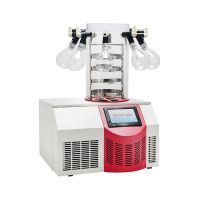Qingdao Carebios Biological Technology Co.,Ltd
Address: No.433-5 Sancheng Road, Lancun Town, Jimo District, Qingdao, 266232, China
Southeast Asia & Australia: Daisy
America: John
Tel: +86 400-118-3626
E-mail: info@carebios.com
Sep - 2021

·
This is the most critical phase. Freeze dryers use various methods to freeze a product.
· Freezing can be done in a freezer, a chilled bath (shell freezer), or on a shelf in the freeze dryer.
· The freeze dryer cools the material below its triple point to ensure that sublimation, rather than melting, will occur. This preserves the material’s physical form.
· A freeze dryer most easily freeze dries large ice crystals, which can be produced by slow freezing or annealing. However, with biological materials, when crystals are too large they may break the cell walls, and that leads to less-than-ideal freeze drying results. To prevent this, the freezing is done rapidly.
· For materials that tend to precipitate, annealing can be used. This process involves fast freezing, then raising the product temperature to allow the crystals to grow.
· The second phase is primary drying (sublimation), in which the pressure is lowered and heat is added to the material in order for the water to sublimate.
· The freeze dryer’s vacuum speeds sublimation. The freeze dryer’s cold condenser provides a surface for the water vapor to adhere and solidify. The condenser also protects the vacuum pump from the water vapor.
· About 95% of the water in the material is removed in this phase.
· Primary drying can be a slow process. Too much heat can alter the structure of the material.
· This final phase is secondary drying (adsorption), during which the ionically-bound water molecules are removed.
· By raising the temperature higher than in the primary drying phase, the bonds are broken between the material and the water molecules.
· Freeze dried materials retain a porous structure.
· After the freeze dryer completes its process, the vacuum can be broken with an inert gas before the material is sealed.
· Most materials can be dried to 1-5% residual moisture.
· Heating the product too high in temperature can cause melt-back or product collapse
· Condenser overload caused by too much vapor hitting the condenser.
o Too much vapor creation
o Too much surface area
o Too small a condenser area
o Insufficient refrigeration
· Vapor choking – the vapor is produced at a rate faster than it can get through the vapor port, the port between the product chamber and the condenser, creating an increase in chamber pressure.
Tagged With: Vacuum freeze dryer, freeze drying, lyophilizer, Pharmacy refrigerator, Cold Storage, Medical Refrigeration Auto Defrost, Clinical Refrigeration, medicine fridge, Cycle Defrost, Freezer Defrost Cycles, Freezers, Frost-Free, Laboratory Cold Storage, Laboratory Freezers, Laboratory Refrigeration, Manual Defrost, Refrigerators